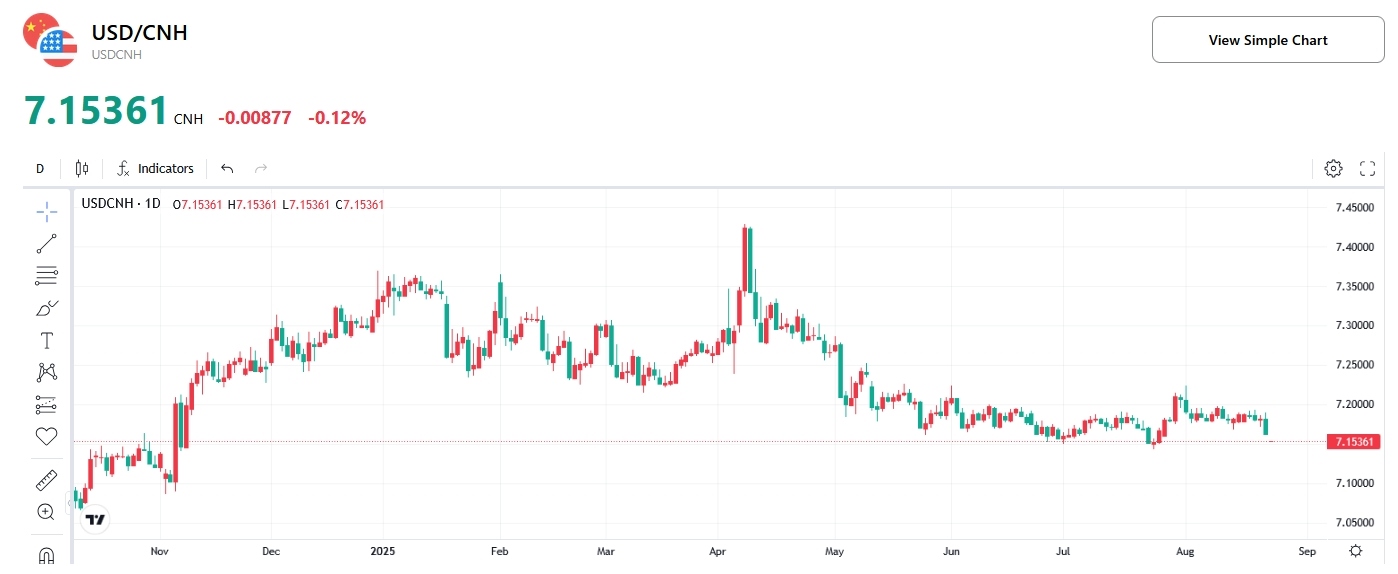Powell’s Dovish Turn Fuels RMB Break Above 7 — The Ripple Effects Go Beyond the Yuan
TradingKey - Federal Reserve Chair Jerome Powell’s speech at the 2025 Jackson Hole symposium unexpectedly reassured markets about a September rate cut. Under the combined influence of domestic and external factors, calls for China’s yuan to appreciate beyond the 7-per-dollar level are growing louder.
On Monday, August 25, the People’s Bank of China authorized the China Foreign Exchange Trade System to announce the central parity rate of the RMB against the U.S. dollar at 7.1161, significantly lower than last Friday’s 7.1321, marking the strongest fixing since November.
As of writing, the USD/CNH exchange rate stands at 7.1536, approaching the year-to-date low set at the end of July.

USD/CNY Exchange Rate, Source: TradingKey
Some strategists noted that although the RMB has strengthened against the dollar, this mainly reflects dollar weakness rather than an intrinsic strengthening of the RMB.
Last week, Powell unexpectedly stated at the global central banking symposium that downside risks to the U.S. labor market are rising, and warned of potential job cuts and a surge in unemployment.
Markets interpreted this as a sign that Powell, who had maintained a cautious stance on rate cuts for months, is now open to easing.
Deutsche Bank and Barclays subsequently revised their rate cut forecasts, now expecting 25-basis-point cuts in both September and December. Previously, Deutsche Bank expected only one cut in December, while Barclays believed rate cuts would not resume until September 2026.
Kuan Tao, Chief Economist at BOC International, predicted last week that the RMB could further appreciate to above 7 per dollar, driven by weaker U.S. economic data, Fed rate cuts, declining confidence in the dollar, and the prospect of a second U.S.-China trade deal.
In addition, Deutsche Bank and UBS have both raised their RMB forecasts to near 7, citing that a final U.S.-China trade agreement would enhance the RMB’s appeal.
Reuters recently reported that China is considering launching a yuan-backed stablecoin to promote broader global use of the RMB. This significant shift in China’s stance on digital assets could provide further support for RMB appreciation.
Beyond external factors, the RMB’s rise has solid domestic fundamentals. China Merchants Securities noted that China’s exports in the first half of the year far exceeded expectations, laying the foundation for RMB appreciation. In the second half, policy focus will shift to structural adjustment, allowing for a moderate slowdown in exports and production. In August, Europe and Japan raised their tariffs on U.S. goods by 5% on average, giving Chinese exports a relative advantage.
The growing expectation of a Fed rate cut restart in September helps ease the misalignment in monetary policy cycles between China and the U.S., narrowing the China-U.S. interest rate differential. If the Fed cuts rates as expected next month, the RMB is likely to appreciate in response — similar to how last September’s Fed rate cut triggered a surge in RMB foreign exchange settlement.
China Merchants Securities believes September is a key observation window for RMB appreciation. If the RMB returns to the 6.x range, and when combined with a rising real effective exchange rate, it would amplify the attractiveness of Chinese equity assets, likely attracting foreign capital inflows and reinforcing inflation and domestic demand strategies — leading to a broad revaluation of Chinese assets.



